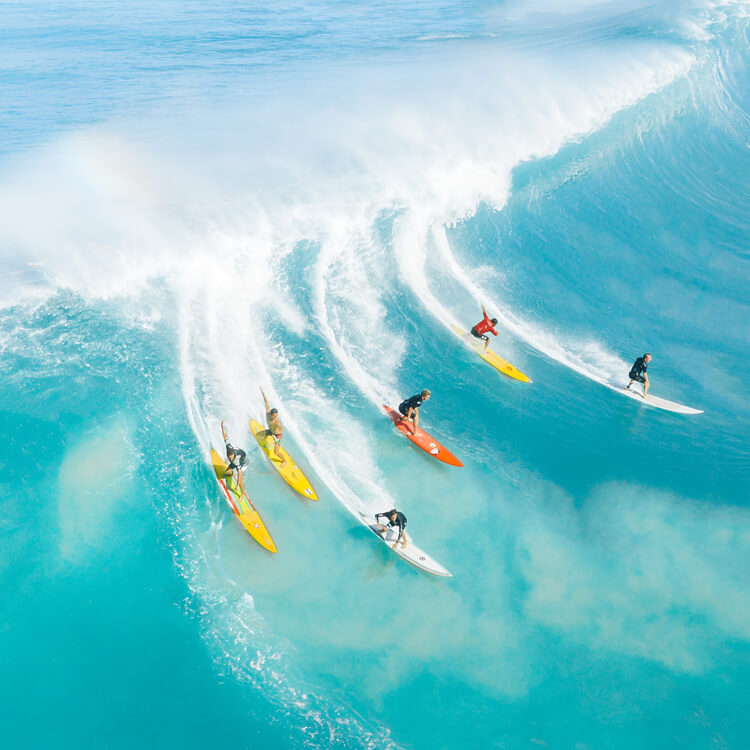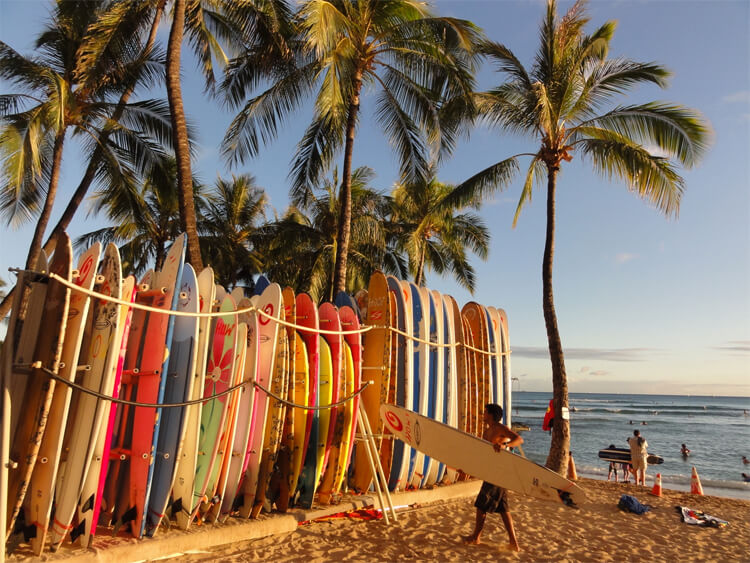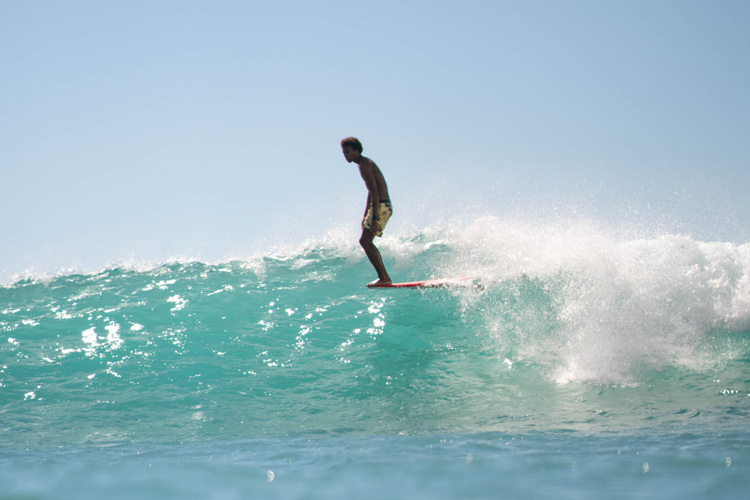In ancient Hawaii, the making of a surfboard required great skill and patience, for after the wood had been cut, it had to be thoroughly seasoned.
Since only stone implements were available to shape it, a year or more might elapse between felled tree and finished product.
A good board became a prized possession, which over the years was thought to acquire a spirit; this acquisition was aided by the incantations of the Kahunas - the high priests of surfing.
Today, as in ancient times, surfing is one of the least expensive of participant sports.
If the modern surfboard is no longer likely to become an heirloom, it is still the only major investment for the neophyte surfer.
Since a board's characteristics may have a great effect on the surfing prowess of the owner, choosing a board is still a ritual of great importance.
In my case, the arrangement with Barry Napoleon had worked out very well.
Since Barry was in the hoard building business, there was a great variety of both new and second-hand boards in a good state of repair in his rental agency on Waikiki Beach.
I tried out fat boards, thin boards, shortboards and longboards, and boards of different width, weight, reinforcement, curvature, and so on.
After a couple of months, I found one I liked. It was a new board, and so I bought it.

Selecting the First Surfboard
If selecting your first board is definitely a big decision when you consider the cost of renting or re-sale, the initial purchase can be quickly written off.
In Hawaii, new boards average $100 to $150.
In California, $75 to $125, although you can pay almost anything, and you can make your own or buy a second-hand board for half these amounts.
The chances are you will want to change your board after about six months when it will still have a resale value of about two-thirds what you paid for it.
So I am going to make a suggestion which may be radical. I believe your first surfboard should be easy to paddle before anything else.
Paddling is extremely hard work, and if your board is difficult to paddle, as many small boards are apt to be, it takes all the joy out of surfing, at least until you have built up your strength, and this, as I have said before, may take several months.
Larry and George, who weighed 175 and 185 pounds respectively, had settled for boards of 9'8'' and 10'2''.
These boards, although quite maneuverable on most waves, were very sluggish to paddle, but both boys were in excellent condition.
I found that my 200 odd pounds were too much for their boards, which were almost pushed underwater by my weight, although I could ride them all right standing up and found them quick and easy to turn.
On consultation with Barry, I settled for a full-railed 11-foot board, 24 inches wide, which was beautifully stable, and as Bob Hansen, our continental friend decided, it was like standing on the sidewalk of Kalakaua Avenue.
However, it was a dream to paddle and forged along like a Mississippi River boat, showing a churning wake to many a stronger surfer with a smaller board.
In my opinion, no beginning surfer over 180 pounds should have a board less than 10 feet long.
Apart from this, exaggerated turn-ups, thin rails, or other way-out features encouraging instability should also be avoided.
Most veteran surfers recommend a compromise all-around board without any eccentric quality - a rather conservative healthy-looking board which many of the established board builders offer for sale.
Remember that a hand-shaped, custom-built board is usually superior to and not much more expensive than pre-shaped or skin-poured boards.
With this in mind, you should test and try out as many kinds of boards as possible. New ones are constantly coming out.
There are dozens of different types, hot dog boards, paddleboards, big wave ( elephant gun) boards, etc., but even among the conservative all-purpose boards, there is an amazing amount of variation which may influence personal choice.
In general, board builders will give you a great deal of help in your selection.
Indeed if you send them your weight, age, and previous surfing experience, they will have a good idea of what kind of board to build for you.
But individual likes and dislikes are hard to analyze, and selecting a board is highly susceptible to personal whim.
Trial and error is undoubtedly the best method.
Experienced surfers, on the other hand, will need boards which are carefully tailored to their body weight and surfing style to ensure maximum control and maneuverability.
Hobie Alter, in his excellent booklet, "Surfing Made Easy," recommends the following table as a guide to board selection.
As an interesting side note, most champion surfers ride boards of 9'6'' or less.
Body Weight > Board Length > Board Width
Under 80 lbs > 8' > 21''
100 lbs > 8'9'' > 21 1/2''
120 lbs > 9' > 22''
150 lbs > 9'4'' > 22 1/2''
180 lbs > 9'8'' > 23''
200 lbs > 10'2'' > 24''
Ten-foot boards and over are usually four inches thick, while 8'6'' boards and under are usually three inches thick, with variations in between.
Surfboard Repairs
Once you have a surfboard, it is certain to need minor repairs from time to time.
Most boards receive a ding or puka (hole) of some kind or other every month or two, and if they are not repaired soon, water will seep in and will alter the riding characteristics of the board.
Foamies are more resistant to water absorption than most previous boards.
Although redwood boards are also highly waterproof, balsa boards are not and will need immediate repair to prevent becoming waterlogged.
In areas where rocks are plentiful, or the conditions are crowded, additional coats of fiberglass are recommended.
An inexpensive Marson epoxy fiberglass repair kit is sufficient to repair most dings in your surfboard.
Complete instructions come with the kit telling you how to clean the surface, mix the filler, and apply it to the repair.
The result may be sanded and painted as desired and is if we believe the manufacturers claim, "stronger than steel."

Storing Surfboards
Surfboards are best stored in vertical racks with a roof to protect them from the rain and sun.
I stored mine in the rack, which was specially constructed by the Moana Hotel next door to the Outrigger Canoe Club.
This cost $4 a month and was extremely convenient.
However, there are many other racks in Waikiki, and most surf clubs have storage places available for members.
Those who contemplate taking their surfing seriously should obviously join a surf club, if only for the stimulation which competition for proficiency among the different age groups brings, and for the surfing friends they will make.
Surfing at Makaha or Sunset involves transporting boards, a problem incidentally which is almost universal in California.
These may be stored inside a station wagon or in the trunks of ordinary cars but will need blankets or other soft material to protect them from hard surfaces and from other boards.
They must also be firmly strapped as surfboards damage easily when subjected to continuous knocking.
Boards may also be carried on the tops of cars. Again padding and tight strapping is necessary to avoid movement and vibration.
Usually, there are straps over each seat which are steadied by slamming the car doors on them; they can also be pulled through the windows and drawn tight near the driver's and passenger's heads.
Probably the best idea is to use racks with rubber suction cups, which are inexpensive and can be stored in the trunk.
Waxing Surfboards
Polyurethane boards have a slick surface which is slippery under foot.
Great difficulty may be encountered if this surface is not covered with wax.
I have seen numerous beginners who were having difficulty trying to stand up on an unwaxed board because the people who rented them the board could not be bothered to tell them about the need for wax.
Ordinary household wax can be cheaply purchased at most supermarkets. Some people swear by beeswax and other preparations.
Wax your board with a circular motion and cover the top and the rails where you are likely to grip them with your hands.
It is a good idea to carry a slab of wax in the car and a cube in your swimsuit pocket in case you get a slick area while out surfing.
Some surfers sandpaper the slippery surface of a new board so that it will hold the wax better.
Words by Desmond Muirhead | Golf Course Designer and Author of the Book "Surfing in Hawaii" (1962)
Chapter VII of "Surfing in Hawaii" was published under the authorization of Rosemary J. Muirhead, one of the three daughters of Desmond Muirhead
